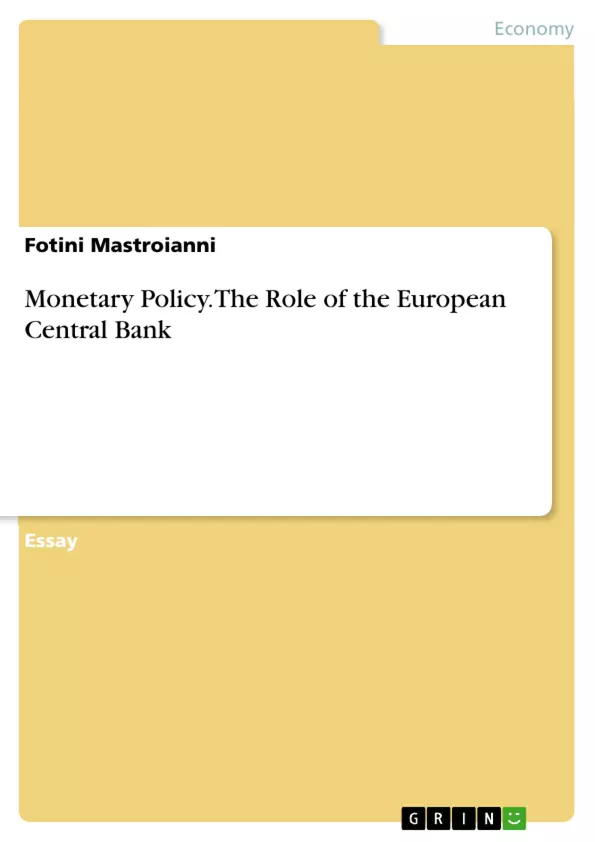The aim of the present paper is to present the monetary policy of the ECB and record the changes in this policy caused by the recent economic crisis from 2007 onwards.
Monetary policy is the process by which the monetary authority of an economic area checks the quantity and the cost of money in the economy. The official goals of monetary policy are the control of inflation, the growth of the economy, the reduction of unemployment and the control of the exchange rate in relation to foreign currencies. Monetary policy may be expansive, namely to increase the amount of money in the market by encouraging economic development, but causing an increase in inflation, or it can be limiting, i.e. to reduce the amount of money in the market by keeping inflation low.
In the Euro Zone, monetary policy is pursued by the European Central Bank (ECB), which was created with the birth of the euro, when it took over the responsibility for the design and practice of monetary policy by the central banks of the Eurozone countries and operates as an independent, supranational but European organization.
Inhaltsverzeichnis (Table of Contents)
- Introduction
- Goals of the ECB Monetary Policy
- Stability of Prices
- A quantitative approach on Price Stability
- The definition of price stability
- The benefits of price stability
- Stability of Prices
- The role of Strategic Monetary Policy of European Central Bank
- The approach based on two pillars
- The Monetary Analysis
- Economic Analysis
- Cross-checking information from the two pillars
- The approach based on two pillars
- The measures taken by the ECB to tackle crisis
- Discussion
- References
Zielsetzung und Themenschwerpunkte (Objectives and Key Themes)
This paper aims to present the monetary policy of the European Central Bank (ECB) and to analyze the changes in this policy caused by the global economic crisis that began in 2007.- Price stability as the primary goal of the Eurosystem
- The quantitative definition of price stability and its benefits
- The two-pillar approach of the ECB's monetary policy strategy
- The ECB's response to the economic crisis
- The impact of monetary policy on the Eurozone economy
Zusammenfassung der Kapitel (Chapter Summaries)
The introduction provides an overview of monetary policy and the role of the ECB. It discusses the goals of monetary policy, including inflation control, economic growth, and unemployment reduction. The chapter on "Goals of the ECB Monetary Policy" focuses on price stability as the primary objective of the Eurosystem. It presents the quantitative definition of price stability, the rationale for its adoption, and the benefits of price stability for the Eurozone economy. The chapter also explores the ECB's commitment to pursuing price stability in the medium term, as well as the risks associated with deflation. The chapter "The role of Strategic Monetary Policy of European Central Bank" explains the ECB's two-pillar approach to monetary policy, which involves the analysis of both monetary and economic data. It also discusses how the ECB utilizes information from both pillars to guide its monetary policy decisions.Schlüsselwörter (Keywords)
The primary keywords and focus topics of this work are monetary policy, price stability, European Central Bank (ECB), Eurozone, economic crisis, inflation, deflation, two-pillar approach, monetary analysis, economic analysis, and monetary policy strategy.- Quote paper
- Fotini Mastroianni (Author), 2016, Monetary Policy. The Role of the European Central Bank, Munich, GRIN Verlag, https://www.grin.com/document/358653



